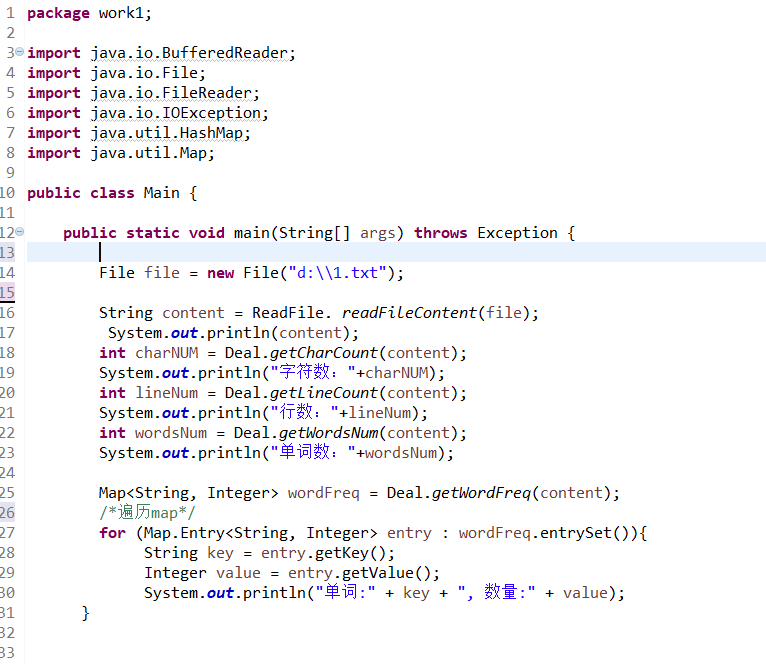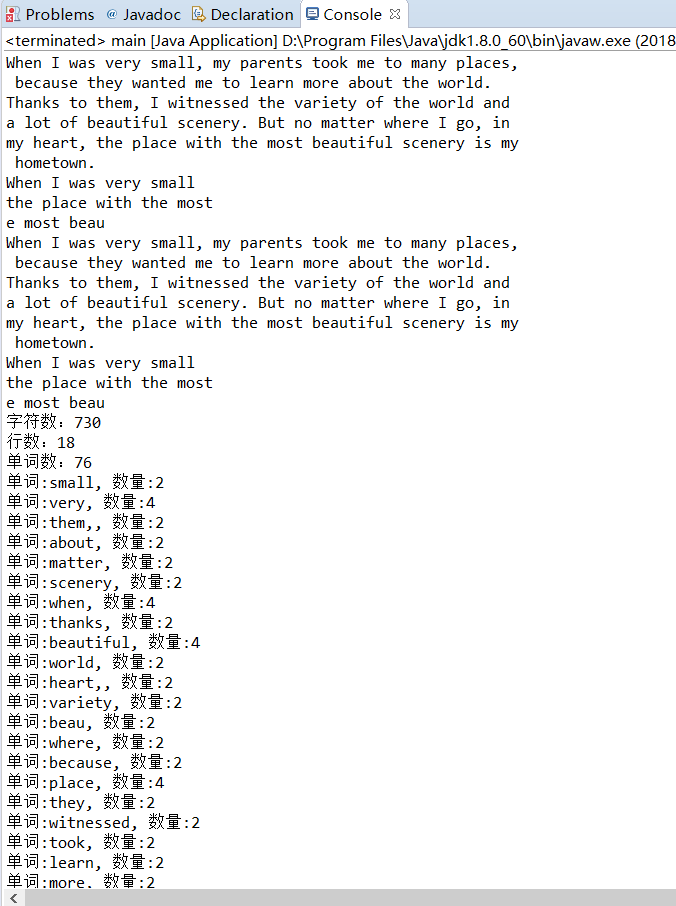软工16个人作业2
实现一个能够对文本文件中的单词的词频进行统计的控制台程序。
进行单元测试、回归测试、效能测试,在实现上述程序的过程中使用相关的工具。
进行个人软件过程(PSP)的实践,逐步记录自己在每个软件工程环节花费的时间。
使用源代码管理系统 (码云)。
1.项目地址
博客作业要求地址:https://www.cnblogs.com/happyzm/p/9559372.html
码云地址:https://gitee.com/wengmingqiang/PersonalProject-C
PSP表格
| PSP2.1 | ** 个人开发流程 ** | ** 预估耗费时间(分钟)** | 实际耗费时间(分钟) |
|---|---|---|---|
| Planning | 计划 | 30 | 40 |
| · Estimate | 明确需求和其他相关因素,估计每个阶段的时间成本 | 20 | 30 |
| Development | 开发 | 700 | 500 |
| · Analysis | 需求分析 (包括学习新技术) | 60 | 80 |
| · Design Spec | 生成设计文档 | 80 | 60 |
| · Design Review | 设计复审 | 30 | 15 |
| · Coding Standard | 代码规范 | 30 | 15 |
| · Design | 具体设计 | 100 | 80 |
| · Coding | 具体编码 | 100 | 180 |
| · Code Review | 代码复审 | 40 | 20 |
| · Test | 测试(自我测试,修改代码,提交修改) | 60 | 180 |
| Reporting | 报告 | 50 90 | |
| · | 测试报告 | 40 | 30 |
| · | 计算工作量 | 15 | 20 |
| · | 并提出过程改进计划 | 10 | 20 |
3.解题思路描述:
拿到这个项目,大致的思路就是,把文件中的字符都读到一个String字符串中,再对字符串进行操作
统计Ascii码:计算string的字符串的长度
统计行数:对文件每行每行的读取,有读取出数据则 行数line++ ,最后返回line
统计单词数:把String函数用split函数对字符串进行划分,存入到一个String数组中,再计算数组的长度
统计单词频度:用键值对(key-value)映射,单词作为key,单词数量作为value。
4设计实现过程
1.项目类的设计
- WordDeal类,设计统计相关信息的方法。
- ReadFile :类用来读取文件中的数据并且存到一个String数组中。
- Main类,调用上面两个类的方法,实现具体功能。
T- est类,用于进行单元测试。
2.代码分析
1.读取文件数据函数
public static String readFileContent(File file) throws Exception {
FileInputStream fis = new FileInputStream(file);
byte[] buf = new byte[1024];
StringBuffer sb = new StringBuffer();
while ((fis.read(buf)) != -1) {
sb.append(new String(buf));
buf = new byte[1024];// 重新生成,避免和上次读取的数据重复
}
return sb.toString();
}
2.获取文件字符 数函数

public static int getCharCount(String text) // 统计文件字符数(ascll码(32~126),制表符,换行符,)
{
char c;
int charNum = 0;
for (int i = 0; i < text.length(); i++) {
c = text.charAt(i); //把字符串转化为字符数组
if (c >= 32 && c <= 126 || c == '\r' || c == '\n'|| c == '\t') {
charNum++;
}
}
return charNum;
}
3.计算行数
public static int getLineCount(String text)throws Exception { // 统计有效行数
int lineNum = 0;
String[] line = text.split("\r\n"); // 将每一行分开放入一个字符串数组
for (int i = 0; i < line.length; i++) { // 找出无效行,统计有效行
if (line[i].trim().length() == 0)
continue;
lineNum ++;
}
return lineNum;
}
4计算单词总数
public static int getWordsNum(String text) {
String content = text.replace('\r', ' ');
content = text.replace('\b', ' ');
content = text.replace('\n', ' ');
String [] words = content.split(" ");
int wordCount = 0;
for(int i= 0; i<words.length;i++)
{
if (words[i].length()<4)
continue;
int j = 0;
for( j =0;j<4;j++)
{
char c =words[i].charAt(j);
if(!((c>='A'&& c<='Z')||(c>='a'&& c<='z')))
break;
}
if(j==4)
wordCount++;
}
return wordCount;
}
5统计单词频率
public static Map<String, Integer> getWordFreq(String text) // 统计单词词频(单词:以4个英文字母开头,跟上字母数字符号,单词以分隔符分割,不区分大小写。)
{
HashMap<String, Integer> wordFreq = new HashMap<String, Integer>();
String content = text.replace('\r', ' ');
content = text.replace('\b', ' ');
content = text.replace('\n', ' ');
String [] words = content.split(" ");
for(int i= 0; i<words.length;i++)
{
if (words[i].length()<4)
continue;
int j = 0;
for( j =0;j<4;j++)
{
char c =words[i].charAt(j);
if(!((c>='A'&& c<='Z')||(c>='a'&& c<='z')))
break;
}
if(j==4)
{
words[i] = words[i].trim().toLowerCase(); // 将字符串转化为小写
if (wordFreq.get(words[i]) == null)
{ // 判断之前Map中是否出现过该字符串
wordFreq.put(words[i], 1);
}
else
wordFreq.put(words[i], wordFreq.get(words[i]) + 1);
}
}
return wordFreq;
}
测试






 浙公网安备 33010602011771号
浙公网安备 33010602011771号